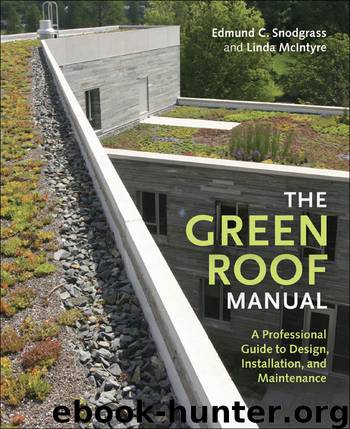The Green Roof Manual by Edmund C. Snodgrass

Author:Edmund C. Snodgrass
Language: eng
Format: epub
Publisher: Timber Press
Published: 2010-09-05T16:00:00+00:00
Stay engaged over the long term
Even after it reaches a relatively steady state, a green roof, like any landscape, is a dynamic system and will change from season to season and year to year. Although it is natural, after one project is installed, for designers to move on to the next project, all landscape projects reward sustained attention. Which plants easily adapt to this kind of site? Which ones struggle? Do the nonliving materials perform as advertised? Observations like these, and making and tracking changes as appropriate in response, do not only help keep a green roof in good working order. They also inform and strengthen subsequent designs in countless ways.
This is especially true of extensive green roofs, because they are such a new technology, at least in North America, and because they are intended to last such a long time. There have been and will continue to be problems as designers and installers determine over time and in some cases by trial and error what works best in different climates and microclimates. The lack of an established North American green roof industry has significant downsides. But there is also an upside in that the marketplace is ripe for innovation.
In Europe, green roofs are standardized utilitarian products. While there is a need here for this kind of inexpensive, no-nonsense green roof, there is also potential to do more—to optimize stormwater performance, to enhance energy benefits, to identify a wider range of plants that will survive on a roof while providing benefits for threatened pollinators or other wildlife, and to otherwise design for better performance.
Academic research will contribute to these potential improvements, but important data could also come from designers and owners who take a long-term interest in what happens on their roofs, use their experience to inform later projects, and share information. Which plants go dormant during long, hot summers? Which ones establish quickly to provide cover but later give way to more dominant species? Does the growing medium hold its physical properties, or does it lose volume or porosity in a few years? Does an irrigation system, even if used only in extreme conditions, contribute to a system’s longevity? The best green roof designers and installers know they have a responsibility for a project’s success, even when their contractual obligations have technically been discharged. Most of them prefer to maintain their own projects whenever possible. They learn from mistakes as well as successes, and they are not afraid to challenge their assumptions. These are the people who will move the industry forward. If you are a designer, you should emulate them. If you are looking for a designer, you should hire people like this.
Download
This site does not store any files on its server. We only index and link to content provided by other sites. Please contact the content providers to delete copyright contents if any and email us, we'll remove relevant links or contents immediately.
Kathy Andrews Collection by Kathy Andrews(11706)
The remains of the day by Kazuo Ishiguro(8787)
Paper Towns by Green John(5061)
Spare by Prince Harry The Duke of Sussex(5052)
The Body: A Guide for Occupants by Bill Bryson(4949)
Industrial Automation from Scratch: A hands-on guide to using sensors, actuators, PLCs, HMIs, and SCADA to automate industrial processes by Olushola Akande(4910)
Machine Learning at Scale with H2O by Gregory Keys | David Whiting(4100)
Be in a Treehouse by Pete Nelson(3922)
Never by Ken Follett(3760)
Harry Potter and the Goblet Of Fire by J.K. Rowling(3758)
Goodbye Paradise(3709)
Into Thin Air by Jon Krakauer(3288)
The Remains of the Day by Kazuo Ishiguro(3279)
The Cellar by Natasha Preston(3241)
The Genius of Japanese Carpentry by Azby Brown(3208)
Fairy Tale by Stephen King(3192)
120 Days of Sodom by Marquis de Sade(3159)
The Man Who Died Twice by Richard Osman(2977)
Drawing Shortcuts: Developing Quick Drawing Skills Using Today's Technology by Leggitt Jim(2974)
